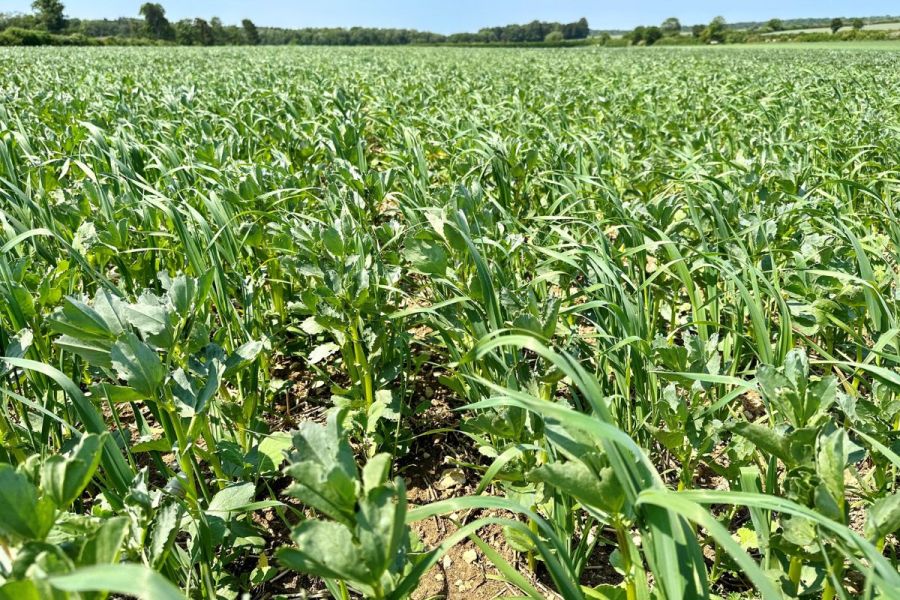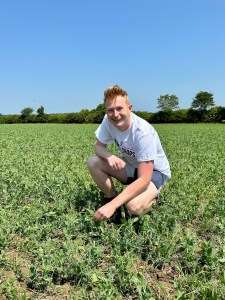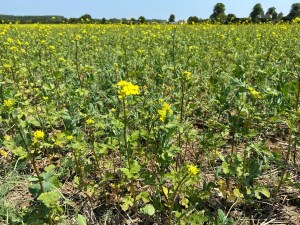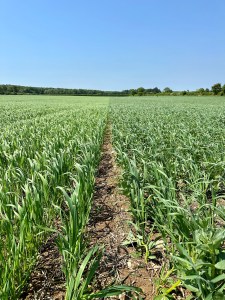
Download PDF
Intercropping, bi-cropping, companion cropping – call it what you like, but interest is increasing. An EU project aims to transform this from a niche to mainstream. CPM reports.
By Mike Abram
It’s perhaps unlikely a workshop about a bi-cropping project would have attracted nearly 50 farmers and advisers from across the country to a farm in Oxfordshire, even five years ago.
But a payment of £55/ha for companion cropping under the new Sustainable Farming Incentive, plus unknowns around nitrogen fertiliser and other inputs, have combined to make the practice more attractive, to at least consider.

Ben Adams established a series of intercropping trials on his farm after winning the ‘Journey to Net Zero’ competition. Photo: Mike Abram.
The workshop was organised by the Soil Association’s Innovative Farmers as part of its role in the Leguminose project. Leguminose, or Legume-cereal intercropping for sustainable agriculture across Europe, to give it its full title, aims to transform legume-cereal intercropping from a niche practice covering just 2% of European arable land to a mainstream method.
UK participation is through the Horizon Europe guarantee scheme, run by UK Research and Innovation (UKRI), which provides funding for researchers and innovators unable to receive Horizon Europe grants while the UK is in the process of associating to the programme.
There’s a two-pronged approach across the 10 countries and 21 organisations involved – firstly collecting data from six research trials sites, which will focus on aspects such as pesticide reductions, soil health, and crop quality and health.
The second part is establishing a network of 180 on-farm living-lab trials to demonstrate the economic, environmental and social benefits of intercropping, helping to overcome barriers to its wider implementation. Around 20 of the living labs will be in the UK, run as Innovative Farmers field labs.
Data from both the living labs and the research trials will be used to develop an interactive, web-based tool to support farmers in selecting the optimal intercrop combinations for their requirements.
The workshop, held at Ben Adams’ 500ha farm near Bicester, also took a two-pronged approach. The first half asked participants to assess the strengths, weaknesses, opportunities and threats of bi-cropping, a so-called SWOT analysis, while the second toured the fields where Ben is growing a range of intercrops.
Workshop groups were split into conventional growers, organic farmers and representatives from supply chain companies for the SWOT analysis, explains senior farming adviser for the Soil Association, Jerry Alford.
Among the strengths identified for intercropping was that it’s an IPM strategy that doesn’t reduce productivity, says Jerry. “Lots of solutions potentially reduce productivity, but intercropping is one where you generally see either an increase in net yield per area or the ability to grow premium crops.”
Typically, legume-cereals intercrop research suggests producing the same combined yield from the monocrops would require around 20-30% more area than when growing the two together.
Other key strengths, participants suggested, were reduced inputs – both nitrogen and pesticides – and increased plant diversity leading to improved soil health and resilience.
Organic growers, perhaps with more intercropping experience, saw weed control as a strength, while conventional growers highlighted it as a weakness specifically due to lack of chemical options, notes Jerry.
“That’s a concern for conventional growers, but we found as part of an Innovative Farmers project there was less weed biomass when you have an intercrop, so the weed control issue may not be as big as they fear. That said, blackgrass is an issue and I’m not going to claim I know whether an intercrop has the same effect on blackgrass – it’s something we’re going to find out.”
Spring-sown intercrop options, particularly if allowing access to a premium market, could help growers to justify rotational changes that would help with blackgrass control, he says.
According to Jerry, the creation of premium markets by intercropping was seen as a major opportunity and that some have already emerged through the likes of Wildfarmed and Hodmedod, but there’s also the chance to replace imported soya with home-grown protein.
Finding a way to price intercrops for this purpose was an identified barrier. “Feed companies are interested but require a way to price mixed loads of beans and wheat, for example.
“If they have to separate to work out what it contains, it’s adding a process which you don’t necessarily require, especially compared with buying a boatload of soya,” explains Jerry.
However, technology could potentially help with that challenge. “We’re already using near infrared technology to measure protein in wheat, so in theory it should be possible to do the same with a combined product. It’s work in progress, but if intercropping becomes mainstream, feed companies might be willing to adapt more,” he says.
The ability to separate crops quickly and cost effectively was seen as a current weakness but also an opportunity, and machinery that could help with that on-farm was likely to speed up adoption.
A lack of agronomic knowledge about growing intercrops was the other main weakness, especially around drilling depths, seed rates and combining issues such as alignment of harvesting dates.
Jerry explains it’s part of the project to look into these questions through the living lab on-farm trials. “We’ve had lots of interest from farmers wanting to be part of the project. We’re looking to conduct at least 20 tramline-type trials looking at strips of monocrops and then the combined intercrop. We’ll be taking grain and soil samples from each of those plots, as well as looking at yields.”
Out in the field, Ben demonstrated his 16.5ha of intercrop mixes across two fields. Although these plots weren’t part of the Leguminose project, Ben is one of around 50 farmers who’ve expressed an interest in taking part in the trials.
Instead, funding for the work came from the School of Sustainable Food and Farming as winner of a ‘Journey to Net Zero’ competition, he says. “I’d completed a few trials over the past few years mostly looking peas and oats, but wanted to do more, so I applied for funding to scale up the complexity and size of my trials.”
For this, Ben says intercrops have been drilled after winter wheat and a not particularly successful overwintered cover crop, which was sprayed off with glyphosate. The intercrops will then be followed by winter wheat and an overwinter cover crop, followed by what performs well in this year’s trials.

A trial plot of mustard and peas companion cropping, as seen at Ben Adams’ farm. Photo: Mike Abram.
Nine different two- and three-way intercrops comprising of one of three different legumes, plus either barley or oats and/or mustard or oilseed rape were drilled into the cover crop residue on 18 and 19 April and left to grow with zero inputs. “The idea is low input, see what works well, and what’s profitable and what isn’t,” says Ben.
To add further complexity, each of the cereal and pulse intercrop species are a blend of three varieties, drilled from separate tanks by a 6m Horsch Avatar at a drilling depth of 3.75cm in the same row.
Looking at the plots in mid-July, interesting differences and observations have emerged, says Ben. “For example, the peas and low seed rate spring barley mix looks a much better proposition than the high seed rate spring barley and vetch mix.
“I was worried the peas would pull the barley down, but so far, that hasn’t happened and it looks good, whereas the barley in the vetch intercrop is shorter and overall the crop is much thinner. It’s probably not going to make much money or leave much N for the following wheat crop,” he says.
Part of that might be down to the low rate of vetch used, he admits. “If I do it again, I’d want the vetch to be drilled at 12-15kg/ha rather than 6kg/ha.”

Low rate oats & beans versus high rate oats & vetch, as seen at Ben Adams’ farm. Photo: Mike Abram.
In the pea and OSR plot, the OSR is starting to pod and appear above the peas after being hidden for much of the spring, he says. “It’s doing better than in the bean/OSR, where I’m not expecting much yield of OSR. But in this plot, blackgrass is more evident, perhaps having grown taller to compete with the peas,” comments Ben.
Mustard at a low seed rate has grown well in the three-way mustard, barley and pea strip. “There are also much fewer weeds – I think the mustard offers some early weed competition. The peas have podded nicely and the barley is a good height, so I’m excited to see how this yields,” he says.
In the second field, where most of the plots include beans except one strip of oats and vetch, the beans and oats plot looks best, explains Ben, with the beans and OSR the poorest.
“Disease and insect control has been good across the plots.” Where rust is starting to come into the beans, Ben suggests the blend of varieties has helped, while crown rust hadn’t been an issue in the oats.
He anticipates harvest in the pea field will likely be in August, with the beans coming in later. “My plan is to hire in a colour sorter for a day to separate the various crops post-harvest,” says Ben.
While harvest will be the final arbiter of success and failure, Ben believes intercropping with the various potential payments within SFI for companion cropping, overwinter cover crops, no insecticides, soil assessments and potentially in the future payments for direct drilling and precision farming, will be a good way of controlling risk on his farm.
“You have quite a bit of money in the bank before you’ve even planted the crop,” he concludes.
This article was taken from the latest issue of CPM. Read the article in full here.





